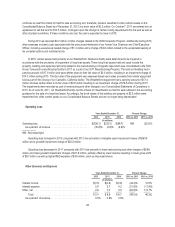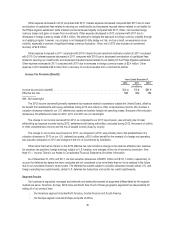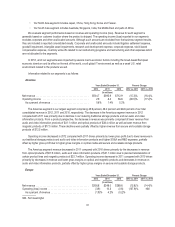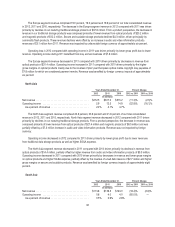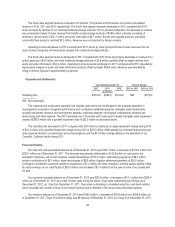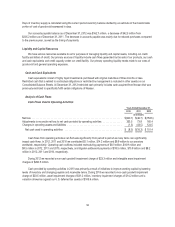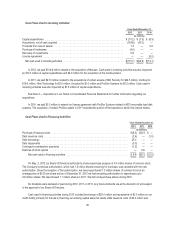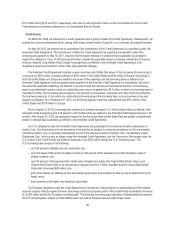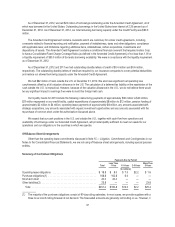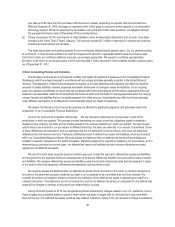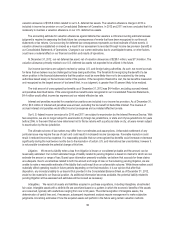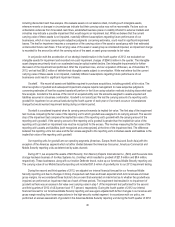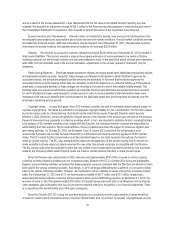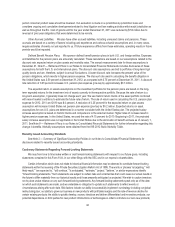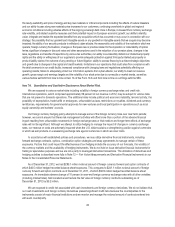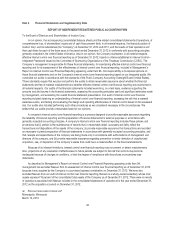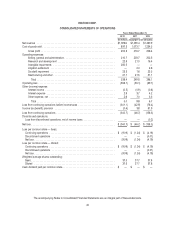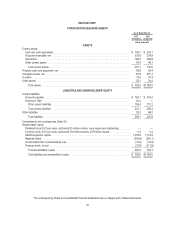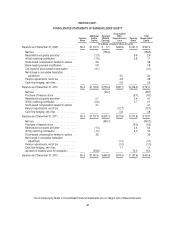Memorex 2012 Annual Report Download - page 41
Download and view the complete annual report
Please find page 41 of the 2012 Memorex annual report below. You can navigate through the pages in the report by either clicking on the pages listed below, or by using the keyword search tool below to find specific information within the annual report.may take up to 60 days from the purchase order issuance to receipt, depending on supplier and inbound lead time.
Effective December 8, 2009, we began an agreement with a third party to outsource certain aspects of our information
technology support. While the agreement is cancelable at any time with certain cash penalties, our obligation through
the expected termination date of December 2016 is included above.
(2) Timing of payments for the vast majority of other liabilities cannot be reasonably determined and, as such, have been
included in the “More Than 5 Years” category. This amount includes $4.1 million of reserves for uncertain tax positions
including accrued interest and penalties.
The table above does not include payments for non-contributory defined benefit pension plans. It is our general practice,
at a minimum, to fund amounts sufficient to meet the requirements set forth in applicable benefits laws and local tax laws.
From time to time, we contribute additional amounts, as we deem appropriate. We expect to contribute approximately
$2 million to $4 million to our pension plans in 2013 and have $28.1 million recorded in other liabilities related to pension plans
as of December 31, 2012.
Critical Accounting Policies and Estimates
The discussion and analysis of our financial condition and results of operations is based upon our Consolidated Financial
Statements, which have been prepared in accordance with accounting principles generally accepted in the United States of
America. The preparation of these financial statements requires us to make estimates and judgments that affect the reported
amounts of assets, liabilities, revenue, expenses and related disclosures of contingent assets and liabilities. On an on-going
basis, we evaluate our estimates to ensure they are consistent with historical experience and the various assumptions that are
believed to be reasonable under the circumstances, the results of which form the basis for making judgments about the carrying
values of assets and liabilities that are not readily apparent from other sources. Actual results may differ from these estimates
under different assumptions or conditions and could materially impact our results of operations.
We believe the following critical accounting policies are affected by significant judgments and estimates used in the
preparation of our Consolidated Financial Statements:
Income Tax Accruals and Valuation Allowances. We are required to estimate our income taxes in each of the
jurisdictions in which we operate. This process involves estimating our actual current tax obligations based on expected
taxable income, statutory tax rates and tax credits allowed in the various jurisdictions in which we operate. Tax laws require
certain items to be included in our tax returns at different times than the items are reflected in our results of operations. Some
of these differences are permanent, such as expenses that are not deductible in our tax returns, and some are temporary
differences that will reverse over time. Temporary differences result in deferred tax assets and liabilities, which are included
within our Consolidated Balance Sheets. We must assess the likelihood that our deferred tax assets will be realized and
establish a valuation allowance to the extent necessary. Significant judgment is required in evaluating our tax positions, and in
determining our provision for income taxes, our deferred tax assets and liabilities and any valuation allowance recorded
against our net deferred tax assets.
We record income taxes using the asset and liability approach. Under this approach, deferred tax assets and liabilities
are recognized for the expected future tax consequences of temporary differences between the book and tax basis of assets
and liabilities. We measure deferred tax assets and liabilities using the enacted statutory tax rates that are expected to apply
in the years in which the temporary differences are expected to be recovered or paid.
We regularly assess the likelihood that our deferred tax assets will be recovered in the future. A valuation allowance is
recorded to the extent we conclude a deferred tax asset is not considered to be more-likely-than-not to be realized. We
consider all positive and negative evidence related to the realization of the deferred tax assets in assessing the need for a
valuation allowance. If we determine we will not realize all or part of our deferred tax assets, an adjustment to the deferred tax
asset will be charged to earnings in the period such determination is made.
During the fourth quarter of 2010, we recognized significant restructuring charges related to our U.S. operations. Due to
these charges and cumulative losses incurred in recent years, we were no longer able to conclude that it was more-likely-
than-not that our U.S. deferred tax assets would be fully realized. Therefore, during 2010, we recorded a charge to establish a
38



